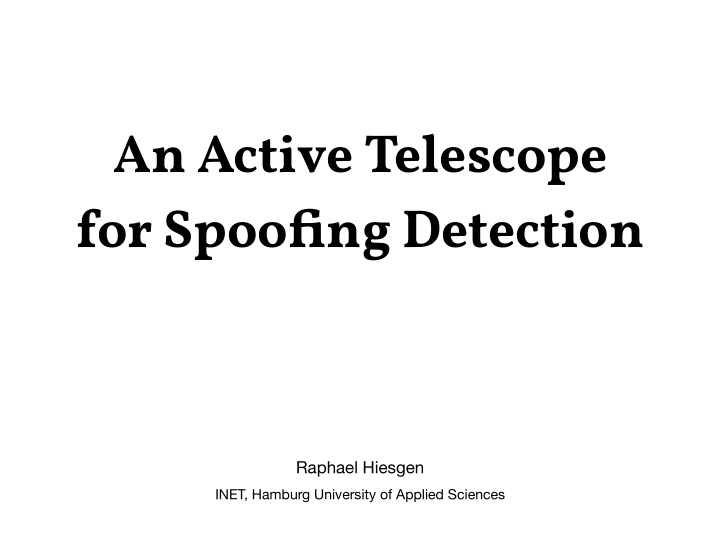



An Active Telescope for Spoo fj ng Detection Raphael Hiesgen INET, Hamburg University of Applied Sciences
Motivation • Spoofing is a problem throughout the Internet • Our focus: impact on measurements • Research and operations depend on reliable data • Source address often used for geolocation • Application domain: UCSD Network Telescope � 2
Goal • Identify spoofed tra ffi c in the IBR • Challenges • One-way communication • Real-time processing � 3
Probing to the Rescue • Introduce active measurements to probe IBR sources • Collect responses for a given source address • Check if initial packet and replies have the same sender � 4
Pseudo Source Address Validation • Idea: Correlate initial IP ID with the IDs of probe replies • Somewhat inaccurate (e.g., not all hosts reply to probes) • Traditionally a system-wide counter • Can be used to attribute packets to the same host • Changed due to privacy concerns • Now often a counter per specific addresses + protocol tuple � 5
IP ID Correlation � 6
Handshake Continuation • Idea: Accept TCP connections (SYN-ACK probing) • High accuracy (only works if the target has state) • Scanner behavior unclear • Some reply with RST, others establish the connection � 7
Spoo fj ng vs. Spoo fj ng • Both methods require probes from telescope addresses • Replies mixed in with telescope tra ffi c • Impact on telescope tra ffi c patterns unknown (so far) � 8
Implementation: Spoki • Native impl. based on the C++ Actor Framework (CAF) • Parallel packet ingestion via libtrace • Probing handled by scamper • Deployed for two IP blocks: Regular Telescope • 44.0.1.0/24 @UCSD IBR Subset B a c Replies Results k Spoki Internet • 91.216.216.0/24 @BCIX e Targets n s e b o r P d Scamper � 9
Challenges • Reliably provoke replies • Handle the data amount in real-time • Identifies valid packets instead of spoofed ones � 10
ICMP • Probe with ICMP echo requests, analyze IP IDs of replies Events/Hour Total Events Got Reply Validated UCSD 40 573 346 (60%) 90 (16%) BCIX 30 464 349 (75%) 85 (15%) � 11
TCP • Send SYN-ACK probe to complete the handshake Per Hour Total Events Got Reply Validated UCSD 5.439 78.705 65,651 (83%) 7,323 (9%) BCIX 5.780 93.682 78,954 (84%) 10,146 (11%) � 12
RST Replies • 15 most targeted ports for events that replied with RST to probes UCSD BCIX � 13
No Replies • 15 most targeted ports for events did not get a reply UCSD BCIX � 14
Regular Replies • 15 most targeted ports for events that replied with non-RST to probes UCSD BCIX � 15
UDP • Reflect payload, analyze IP IDs of replies Per Hour Total Events Got Reply Validated BCIX 215 3.241 175 (5%) 23 (1%) � 16
Services • 30 most targeted ports BCIX � 17
Provoking UDP Replies • Problem: no standardized communication protocol • Attempts so far: • Send service-specific probes • Send newline characters • Reflect payloads • Reply with ICMP destination unreachable — MTU exceeded � 18
Next Steps • Methodology • Validate the TCP results or find out how to improve them • UDP is very unstable and requires work • How to extend the inferences to the entire /8? • Can we transfer the technique into other contexts? � 19
Recommend
More recommend